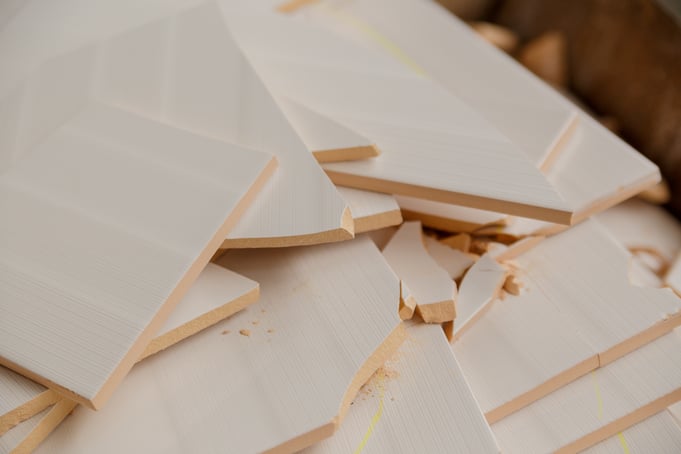
The video underneath shows an Indonesian factory producing large porcelain tiles. These white body tiles measure 120cmx60cm and, as you can see, due to its large size and thinness, they break easily during the production process, especially in those plants where layout imposes direction and/or level changes. Breakages and cracks are usual and happen for several reasons. The good news is that there are also various ways to deal with them. In the video, adding additives was the most effective way to mitigate this breakage rate.
PORCELAIN WHITE BODY TILES
The tiles shown in this video are porcelain stoneware. Porcelain stoneware tiles are shaped by pressing a powdered body and the fired product has a water absorption lower than 0.5%. Porcelain stoneware is known to have a high mechanical strength, even so it is normal to see cracks while producing them, due to the use of low plasticity raw materials.
Commonly, porcelain stoneware tile bodies have a 1:1 ratio between plastic components (like clays and kaolin) and non-plastic components (like feldspars and quartz). Nonetheless, to promote sintering, small percentages of calcite, dolomite and talc are sometimes added depending on the type of clay used. The clay type will have a great impact on your production. Here are some examples of clays and their properties:
|
|
SiO2 |
TiO2 |
Al2O3 |
Fe2O3 |
K2O |
Na2O |
Loss upon firing % |
Mechanical resistance N/mm2 |
|
Vesko Granitik |
59.0 |
1.4 |
25.0 |
0.8 |
2.2 |
0.5 |
9 |
9.0 |
|
Ceraterra TSMA |
60.0 |
0.5 |
26.0 |
1.3 |
0.8 |
0.11 |
10 |
8.0 |
|
Fuchs FT-A |
63.0 |
1.4 |
25.0 |
1.0 |
2.2 |
0.2 |
7 |
6.0 |
|
Fuchs FT-S |
65.0 |
1.4 |
23.0 |
1.0 |
2.2 |
0.1 |
7 |
6.0 |
|
Fuchs Pím |
63.0 |
1.3 |
25.0 |
1.7 |
2.4 |
0.2 |
7 |
6.0 |
|
Sarcal KSG |
50.0 |
1.3 |
33.0 |
1.3 |
0.6 |
0.1 |
12 |
- |
|
Sarcal BS3 |
46.0 |
1.4 |
36.0 |
1.3 |
0.5 |
0.1 |
14 |
- |
|
Damrec RC 593 |
- |
1.3 |
27.0 |
1.2 |
- |
- |
10 |
5.0 |
|
Damrec RC 784 |
- |
1.5 |
26.0 |
1.4 |
- |
- |
10 |
6.0 |
|
EuroArce 951 |
56.0 |
0.8 |
29.0 |
1.4 |
2.1 |
0.2 |
9 |
- |
|
EuroArce 952 |
61.0 |
0.8 |
25.0 |
1.4 |
2.1 |
0.2 |
9 |
- |
|
EuroArce 960 |
51.0 |
0.2 |
32.0 |
1.2 |
1.2 |
0.8 |
12 |
- |
|
ECC Hyplas 67 |
65.0 |
1.7 |
23.0 |
1.0 |
2.0 |
0.4 |
6 |
7.0 |
|
ECC Hyplas 71 |
69.0 |
1.7 |
20.0 |
0.9 |
1.9 |
0.4 |
5 |
7.0 |
|
Stephan Schmidt 301 |
63.0 |
1.5 |
24.0 |
1.0 |
1.9 |
0.2 |
7 |
4.0 |
|
Stephan Schmidt 1033 |
65.0 |
1.6 |
22.0 |
1.1 |
1.9 |
0.2 |
7 |
4.0 |
|
Stephan Schmidt 0747 |
71.3 |
1.5 |
22.1 |
1.4 |
2.4 |
0.3 |
6.6 |
3.3 |
|
TGA 7023 |
74.9 |
1.4 |
19.2 |
1.1 |
2.1 |
0.1 |
5.2 |
3.5 |
|
TGA 7036 |
73.5 |
1.3 |
22.0 |
1.3 |
2.1 |
0.2 |
5 |
4.5 |
From PORCELAIN STONEWARE. Production manual and method of use. Dr. Giovanni Biffi (1999)
WHY DO THESE TILES BREAK?
As mentioned before, porcelain stoneware has a high mechanical strength once fired in comparison to other type of materials. However, these type of tiles cannot always stand the harsh process that they go through, making it for tile manufacturers very difficult to maintain an efficient production process. The most common reason why tiles break is that they don't have enough flexibility or MOR to go through the production process. This is usually because low plasticity clays are being used, not too much pressure is being applied to produce the tile body or because the machinery is not well adapted to producing these type of slab tiles.
HOW TO MITIGATE BREAKAGE?
It is clear that tiles with big dimensions are a trend and will continue to be for a while. However, tile breakage issues are very common when manufacturing them. In some plants a breakage rate of over 20% can be experienced, making the productivity of the factory very inefficient. So, how can we manufacture efficiently thinner and larger tiles?
There are several ways to optimize or reduce the percentage breakage in a production line of decorative tiles. The future tile manufacturers will be able to benefit from modernized and advanced machinery that will allow to have shorter production lines, reducing the movement of the tiles, thus reducing breakage.
The use of high plasticity raw materials would be another way to reduce breakage. However, having to change your source and its high cost may be a limitation to implement this change.
Finally, the use of additives, especially created and developed for large tiles. This could be a cost effective way to optimize your production process and reduce tile breakage.
You can read more about tile breakage here: How to avoid tile breakage when producing large and thin tiles.





